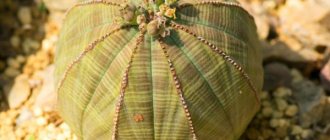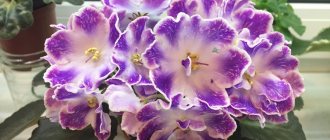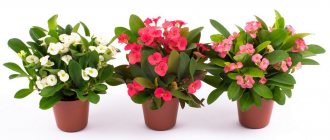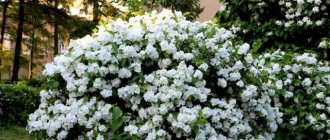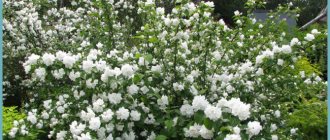Description
Garden spurge belongs to a large genus, which includes about two thousand plant species, which, in turn, belong to the Euphorbiaceae family.
The huge species diversity includes both annual and biennial plants, as well as perennial plants. Among the many euphorbias there are highly ornamental and weedy species that gardeners have great difficulty removing from their plots.
For the most part, representatives of the genus are found in African territories, but about 20 species are perfectly adapted to the harsh realities of the Russian climate.
Unfortunately, precisely because of the species diversity, it will not be possible to give a general description of milkweeds , since the plants have strong differences in stem height, leaf shape and bush structure.
But all milkweeds have one thing in common: milky sap.
For people who are allergic to latex, contact with the milky juice is strictly prohibited. The fact is that the juice contains rubber - a natural raw material for the production of latex.
You need to be very careful when working with milkweed: a couple of drops of juice on the skin can cause itching, redness and even ulcers.
If it gets into the eyes, it leads to partial loss of vision and severe burns to the cornea. The juice that reaches the stomach causes severe vomiting , diarrhea, and increased body temperature.
When they bloom, milkweeds produce attractive, brightly colored petals that are mistaken for flowers. But these are not petals, but leaf plates that are designed to attract insects to pollinate the flower itself, which is rather inconspicuous.
Main varieties
Iberis perennial planting and care photo
In our country there are about 160 species, but garden spurge is most often grown. In turn, it is divided into dozens of other varieties, among which are:
- Euphorbia multiflora. Perennial, growing up to 70 centimeters. More often than other species, it is grown in the countryside, as it is resistant to temperature changes. Euphorbia multicolor also does not require specific care. It grows successfully even in the snowiest regions of the Russian Federation. From May to July, the leaves are colored light green, then acquire an unusual lemon color.
- Another popular species is almond euphorbia with showy light green flowers that appear from April to June. A light blow of wind is enough for the flowers to start swaying - it all looks very impressive. The height reaches 60 centimeters. Withstands light frosts down to -15 degrees.
- Cypress. Can withstand temperatures down to -20 degrees. It grows up to 40 centimeters, and from a distance the plant resembles coniferous branches. During flowering it turns into a fluffy ball.
- Capitate. Like other garden spurges, it is unpretentious to soil and sudden drops in temperature. It is somewhat reminiscent of yellow spurge due to its characteristic shade during the flowering period. However, the plant is much lower, growing up to 10 centimeters. It reproduces by thin shoots and quickly displaces other crops from the site. Therefore, you need to be careful to prevent overgrowth in the garden.
- Myrtifolia. It is mainly cultivated by amateur flower growers and landscape designers, as it has an unusual leaf shape. Loves warmth and feels comfortable in the southern regions.
Those who love warm climates are the fiery and Mediterranean varieties of spurge. In other regions, long-horned, stone-loving spurge is planted.
Garden spurge: types, photos and names
From almost 2000 varieties, every gardener will be able to choose a plant to their liking. Among the most popular ones used for garden decoration are the following.
Multiflora or polyflorum (Euphorbia epithymoides)
The natural habitat of this species is the mountainous regions of Europe. The perennial plant in the process of development forms a beautiful rounded crown of the correct shape, which, with a bush height of 0.5 to 0.7 m, creates an attractive picture.
The basal leaves are scaly, they form a rosette; the same ones that are located on the stem, round in shape. The leaf-spreads are painted in a light yellow tone, which acquires a beautiful orange color at the time of flowering. The flowering period takes a little more than a month, occurring in May – June.
Almond (Euphorbia amygdaloides)
A fairly large perennial, whose height can reach 0.7 m. Moreover, the underground part, represented by a horizontal woody root, often coincides in size with the above-ground part.
In the first year of life, the bush produces vertically oriented shoots, which become woody over time. They are densely covered with petiolate dark green leaf plates of an elongated elliptical shape.
The apical rosette of leaves overwinters on the bush, and the next year small shoots appear from it, covered with sessile greenish-yellow leaves framing the peduncles.
Flowering occurs in April - May.
Cypress (Euphorbia cyparissias)
A low (up to 0.4 meters) variety of milkweed with erect shoots, densely covered with needle-like leaves. As it grows, it forms dense clumps.
A notable feature of the plant is its ability to re-bloom : the first wave occurs in May, the second at the beginning of autumn. When flowering it spreads a pleasant aroma.
The petals-spreads of some varieties may have a delicate pink color, but in most plants they have a purple or burgundy tint.
Marginata (Euphorbia marginata)
Grown as an annual, it is distinguished by well-branched, vertically oriented shoots, whose height can reach 0.8 m.
The shoots are densely covered with light green, fairly large (up to 4 cm in length) oval-shaped leaf plates. The arrangement of leaves can be alternate or whorled.
The bush is characterized by long flowering , which lasts from July to mid-September. At this time, the apical leaf plates of garden milkweed receive a bright white border, and the bedspreads surrounding the inflorescence turn completely white.
Myrtle leaf (Euphorbia myrsynites)
This plant is simply irreplaceable when decorating rocky areas or alpine hills. The fleshy creeping stems are not too tall, their length is only about 0.2 m. The shoots form rosettes.
On the stems there are a large number of medium-sized leaf blades of an obovate shape with a remarkable greenish-blue color.
At the top of each shoot, capitate inflorescences are formed . The leaves that form the blanket are tightly curled around the flower and vaguely resemble a rose with greenish-yellow petals.
The flowering period takes all of May and most of June, but in warm springs flowering can begin in April. The plant reproduces well by self-seeding; this must be kept in mind when planting.
Capitulata (Euphorbia capitulata)
An interesting compact variety. Prefers rocky, well-lit areas. The height of the shoots is about 0.1 m. The flowering period occurs at the end of spring, and at this time capitate spurge becomes an expressive decoration of the site.
Stone-loving (Euphorbia petrophila)
A herbaceous perennial plant whose shoots at the base become woody over time. The color of the stems has a reddish or brownish tone. The height of the shoots does not exceed 0.2 m.
Foliage from previous years leaves scar marks on the stems, which can be used to approximately determine the age of the plant.
The leaf blades have an elongated elliptical shape, about 2 cm in length, and are distinguished by the presence of a serrated edge. The color of the foliage is greenish-gray, the integument is leathery, and the leaves themselves are quite dense.
Flowering occurs at the end of May and lasts until the beginning of July. The inflorescences are wrapped in burgundy egg-shaped blankets ; they are formed by 3–5 flowers.
Swamp (Euphorbia palustris)
The color of the erect long shoots, reaching a meter in length, is noteworthy - it is burgundy.
There is a lot of foliage on the shoots; it is rich green with a noticeable light cream longitudinal vein. The flowering period occurs at the end of May, at which time the plant forms fiery yellow inflorescences.
Chin or caper (Euphorbia lathyris)
This variety has a two-year life cycle and quite impressive growth (up to 1.5 m). The plant is suitable for areas located in light shade.
In the first year of life, milkweed produces an erect shoot, distinguished by a reddish color. In the second year it forms flowers and dies after flowering. The variety reproduces well by self-sowing.
Vegetable garden (Euphorbia peplus)
Since this variety is completely undemanding to soil quality and instantly reproduces by self-sowing, it is often pulled out as a weed.
But a certain decorative quality is still inherent in the low bush. And if you monitor the growing season of the plant, and immediately remove the corollas after flowering, then garden spurge may well be present on the site.
Griffith or fire (Euphorbia griffithii)
This large (up to 0.8 m in height) plant is a striking example of highly decorative milkweed. Its vertical shoots form a rounded bush and are densely covered with elongated leaf blades with a bright longitudinal stripe on each.
During the flowering period, inflorescences with red, orange or yellow petals appear on the shoots.
Cornigera (Euphorbia cornigera)
Not too bright, but an atmospheric plant, whose bush is formed by erect shoots up to 0.8 m long. The flowering period occurs in the second half of summer.
The plant forms inflorescences of horny greenish-yellow flowers. The leaves are elongated-lanceolate, dark green, with a noticeable light stripe in the center.
Schilling's (Euphorbia schillingii)
A tall bush can reach 1 m in height and serves as an excellent background for flowering perennials without overwhelming them with its blooms.
The color of the petals is yellowish-green, but not too bright. The leaf blades are elliptical in shape, rich green in color, and are distinguished by a noticeable longitudinal stripe.
Mediterranean or sculptured (Euphorbia characias)
It is distinguished by its large bush size (up to 1.5 m), early and long flowering. During the flowering period, the bush is abundantly covered with inflorescences-tassels of light green color. The bluish-green leaves have a beautiful elongated shape.
Altai (Euphorbia altaica)
A herbaceous perennial whose height does not exceed 0.2 m. The shoots do not branch; they are divided into generative and vegetative.
The shape and size of the leaves vary: at the base of the shoot they are ovoid and medium-sized (about 3 mm), at the top of the shoot the length of the leaf can already reach 3 cm, and its shape takes on an elongated oval shape.
During the flowering period, yellow-green umbrella inflorescences with a wide bell-shaped leaf-spread appear on the tops of the shoots.
Rocky (Euphorbia rupestris)
A low bush, whose vertical shoots do not exceed a height of 0.2 m. There are few leaves on the shoots, thanks to which the openwork shape of the bush .
The leaf plates themselves are very beautiful; they constitute the main decorative value. The leaf length can reach 4 cm with a width of 1.5 cm; they are painted in a bluish tone, but have bright white veins.
Scaly (Euphorbia squamosa)
This spurge attracts attention with the correct spherical shape of the bush. The height of the plant reaches 0.4 m. Oval light green leaves and yellow inflorescences complete the picture.
Reproduction methods
Euphorbia reproduces in different ways:
- seed;
- cuttings;
- dividing the bush.
Seeds
Many varieties of euphorbia are able to reproduce by self-sowing. Plants are dioecious. To breed them, it is worth combining male and female specimens on the site. It is possible to determine the sex only during the flowering period:
- in male plants, flowers are distinguished by a more elongated and narrow shape and the presence of large pistils;
- females have a wide shape and many stamens.
Cuttings
Most types of milkweed can be propagated by cuttings. This method is usually used in late spring - early summer. To do this, perform the following steps:
- Young shoots are cut off.
- The juice is washed off with water.
- Sprinkle the sections with activated carbon powder.
- Dry the cuttings for 1–2 days in a warm room.
- Drainage and a soil mixture of peat, leaf soil and sand, taken in equal proportions, are poured into the planting boxes.
- The soil is moistened.
- Cuttings are deepened into it.
Rooted milkweed is transplanted into open ground after a month.
Expert opinion
Stanislav Pavlovich
Gardener with 17 years of experience and our expert
Ask a Question
Note! Stone-loving and scaly spurges cannot be propagated by cuttings.
Growing plants from cuttings
Euphorbia is an unpretentious crop that is easy to care for and does not cause much trouble when growing.
Plants propagate well from root or stem cuttings.
To do this, the prepared material is placed in a peat substrate. The plantings are covered with film to create a greenhouse effect and regularly sprayed with a spray bottle.
For quick rooting, you need to maintain high air humidity and keep the substrate slightly moist all the time.
Due to high humidity, the greenhouse is opened daily for ventilation to prevent mold from growing.
A sign that the cuttings can be planted in individual pots and the shelter removed will be the appearance of new shoots.
Necessary conditions for a flower
An attractive decorative perennial appearance, ease of care and propagation have made milkweed a favorite of gardeners. Despite the fact that milkweed, like most succulents, is not particularly demanding, there are points in its cultivation that are worth paying attention to. To choose the right conditions for growing any plants, it is important to find out their natural habitat.
Selection of location and soil
The place for planting milkweed should be well lit by the sun , short shading is acceptable.
Some species can grow in very shady places, but this is rather an exception to the rule. As befits a succulent, the plant loves the sun. The soil should be loose, porous, well-drained, with an acidity slightly above average (approximately ph 6-7). Milkweed will not like overly fertile soil. For moderate enrichment, you can use humus, which will also make the soil looser and lighter. The rich mineral composition of the soil is of great importance for succulents.
It is also important that the space around the bush is free of weeds; they should be weeded out in a timely manner.
The optimal soil composition is considered to be:
- garden soil - 1 part;
- peat soil – 1 part;
- sand – 1 part;
- brick chips and wood ash - 1 cup per plant.
Important: if you choose a tall variety, add half a part of rotted humus or compost to the soil.
Temperature, humidity, light
If the plant type is selected so that the growing conditions in the garden are as close as possible to natural ones, then no additional requirements will arise.
Most species even spend the winter without additional shelter. Euphorbia is a sun-loving plant, and for a comfortable existence it needs to be in the sun for at least 6 hours a day. Like any succulent, it does not tolerate high soil moisture , so drainage with good drainage capabilities and air circulation must be provided.
The appropriate temperature depends on the specific variety, and ranges from 19 to 28 degrees above zero. During the rest period it is within 10-15 degrees.
Planting and care in open ground
Many types of milkweed are completely undemanding in terms of keeping conditions and reproduce well by self-sowing. But in order for the bush to actively develop and bloom luxuriantly, it will require a simple set of care measures.
Selecting a location
In most cases, preference should be given to open, well-lit areas with loose, permeable soil. But even on poor, acidified soils, spurge will not disappear, the flowering will simply be less spectacular.
Deadlines
The optimal time for planting seedlings or rooted cuttings will be mid-May - the time when the threat of return frosts has completely passed.
Outdoor sowing of seeds
The second half of May is also suitable for sowing seeds in the ground.
To improve the germination of seeds, it is recommended to stratify them (keep them in the refrigerator for two weeks), after pre-treating the surface with fine sandpaper.
Watering mode
Euphorbia is surprisingly unpretentious; it is recommended to water it only in hot weather .
However, you should not allow the soil to dry out after planting young plants - this threatens to reduce the growth rate of the plantings.
Cloning by dividing a bush
The division of the bush, depending on the region, is carried out 2 times a year: either in early spring, or before the onset of frost, in late autumn. When dividing a bush, proceed with extreme caution. Having divided the rhizome, leave its parts for the time necessary to stop the discharge of milky juice.
After the juice stops oozing, rinse the roots in a shower with lukewarm water. To avoid infection, treat the roots with gliocladin and plant them in flower pots prepared in advance. It is important to understand that this operation is poorly tolerated by the plant’s root system. It is even possible that further adaptation will last for 2-3 years, during which the possibilities of flowering will be very limited.
Diseases and pests
The only disease that poses a threat to milkweed is a fungus, the development of which is provoked by high soil moisture. To prevent the development of the disease, it is enough to follow the watering regime.
Dangerous pests include mealybugs and spider mites. Insecticides will help reduce insect activity.
Varieties that are most popular with gardeners
Indoor spurge flower - description and care
Popular flower varieties:
- Kilimanjaro. Height up to 70 cm, silver foliage with a white border. The inflorescences are small, the petals are white;
- Rock crystal is similar in appearance to the Kilimanjaro variety;
- Mountain snow. The foliage is silvery-green, the inflorescences are small and inconspicuous;
- Early snow. Height up to 70 cm. Leaves are oblong with a white border. The white flowers are small and inconspicuous in appearance;
- Climber. The stems are thick, the leaves are small. The inflorescences are spherical yellow in color;
- Obergonia De Negri. The stem is spherical and covered with thorns. Forms one large white flower;
- Albomarginata forms a lush foliage rosette;
- Dexter. The flowers are small, salmon-colored. The foliage is a rich light green color.
Mountain snow variety
